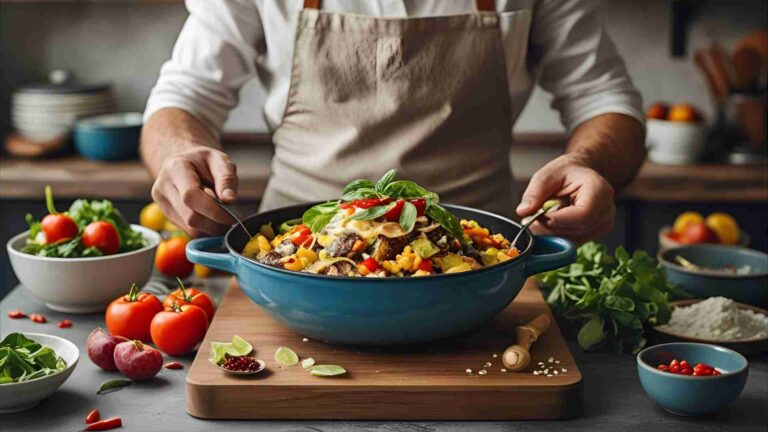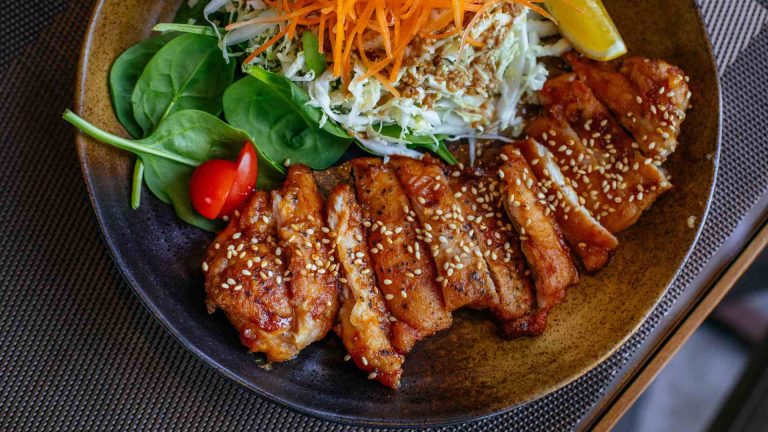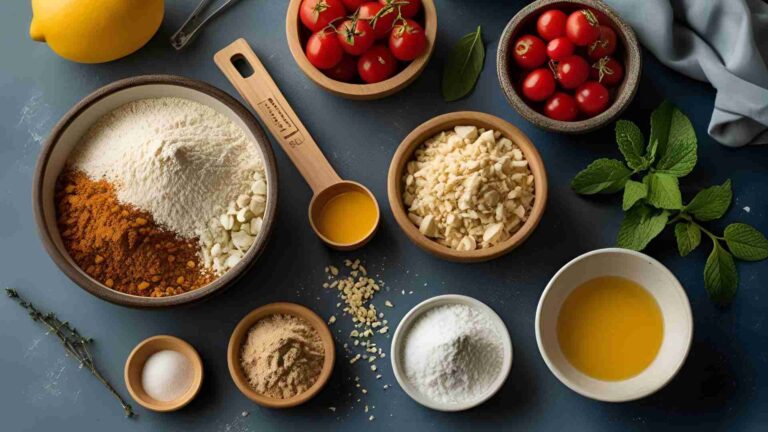Boost Your Cooking Recognition: Recipe Submission Tips
Master recipe submission with expert tips to boost your cooking recognition on top platforms like Tasty, Yummly, and Allrecipes.
Sharing your culinary creations with the world is an exciting way to gain recognition, connect with food enthusiasts, and build your personal brand. Whether you’re a home cook, a food blogger, or an aspiring chef, submitting recipes to popular platforms can elevate your dishes from kitchen favorites to widely celebrated creations. This comprehensive guide provides actionable tips to navigate the recipe submission process, optimize your submissions for success, and maximize your reach across platforms like Tasty, Yummly, Allrecipes, and FoodGawker. From crafting compelling titles to leveraging tools like WP Recipe Maker, we’ll cover everything you need to know to get your recipes published and noticed.
Understanding the Recipe Submission Landscape
The world of recipe submission offers a variety of platforms, each with unique audiences and guidelines. Food blogs, online magazines, print publications, recipe-sharing websites, and community forums are all viable options. Choosing the right platform is critical to ensuring your recipe resonates with its intended audience. For example, some platforms specialize in gourmet dishes, while others focus on vegan, budget-friendly, or family-oriented recipes.
To select the best platform, start by assessing your culinary style and target audience. Are you creating plant-based dishes for health-conscious eaters, or hearty comfort foods for families? Make a list of platforms that align with your niche. Research their submission guidelines to understand their requirements, such as formatting, photography standards, or thematic calls for submissions. This initial step ensures your recipe is a good fit and increases your chances of acceptance.
Why Originality Matters
Submitting original recipes is non-negotiable. Platforms prioritize unique content to avoid copyright issues, and your work—text, images, and videos—must be your own. Repurposing someone else’s recipe or images can lead to rejection or legal complications. Originality also strengthens your personal brand, showcasing your creativity and authenticity to editors and readers alike.
Crafting a Winning Recipe Submission
A well-crafted recipe submission is more than just a list of ingredients and steps. It’s a carefully curated package that includes a compelling title, an engaging introduction, precise ingredients and methods, and high-quality visuals. Below, we break down each component and provide tips to make your submission stand out.
1. Creating a Compelling Title and Introduction
Your recipe’s title is the first impression editors and readers will have. It should be clear, descriptive, and enticing. For example, “Spicy Andouille and Chicken Creole Pasta” is more specific and search-friendly than “Mardi Gras Pasta.” Incorporate key ingredients or unique aspects of the dish to boost discoverability, as many users search by ingredient names.
The introduction sets the tone and hooks the reader. Share the story behind the recipe—perhaps it’s a family heirloom or inspired by a cultural tradition. Keep it concise yet engaging, balancing creativity with clarity. For instance, a description like, “This pan-seared tilapia is a quick, flavorful weeknight meal packed with nutrition and perfect with fresh veggies,” excites readers while clearly explaining the dish.
2. Writing a Clear Ingredients List and Method
A precise ingredients list and method are the backbone of your recipe. Editors and readers need to understand exactly what’s required and how to execute the dish.
Ingredients List
- Be Specific: Include exact measurements, such as “1 cup shredded Cheddar cheese” instead of “cheese.” Specify preparations, like “1 onion, chopped” or “1 teaspoon minced garlic.”
- Order Matters: List ingredients in the order they’re used to streamline the cooking process.
- Adapt to the Platform: Align measurements with the platform’s standards. For example, U.S.-based platforms like Allrecipes prefer cups, while others may use grams. Tools like WP Recipe Maker can automatically convert units for international audiences.
Method
- Be Thorough: Write clear, step-by-step instructions. Instead of “mix everything,” specify “In a large bowl, whisk flour, milk, eggs, and sugar until smooth.”
- Include Technical Details: For oven recipes, note preheating and exact temperatures (e.g., “Preheat oven to 350°F”). For stovetop dishes, specify heat levels (e.g., “medium-high heat”).
- Provide Doneness Cues: Help cooks determine when the dish is ready. For example, “Bake until a toothpick inserted in the center comes out clean, about 30 minutes.”
- Test Your Recipe: Have friends or family test your method to ensure it’s easy to follow and yields consistent results.
Additional Details
Include practical information like:
- Servings: Specify the yield, e.g., “Serves 4” or “Makes 12 cupcakes.”
- Prep and Cook Time: Note how long the recipe takes, e.g., “Prep: 15 minutes, Cook: 30 minutes.”
- Difficulty Level: Some platforms require a difficulty rating, which testers can help determine.
3. Capturing Appetizing Visuals
A high-quality photo is essential for making your recipe stand out. Editors judge submissions based on visual appeal, and readers are drawn to dishes that look delicious. You don’t need professional equipment—smartphone photography with good lighting and composition can suffice. Here are some tips:
- Lighting: Use natural light near a window to avoid harsh shadows.
- Styling: Arrange the dish attractively, using garnishes or props to enhance appeal.
- Focus: Ensure the dish is the star of the photo, with minimal distractions.
- Video Option: A short video demonstrating key steps can make your submission more dynamic and engaging.
Recipe Submission Checklist
Here’s a quick reference to ensure your recipe includes all necessary components:
| Component | Example |
|---|---|
| Ingredient Measurements | 1 cup white sugar, 8 oz spaghetti |
| Ingredient Preparations | 1 onion, chopped; 1 tsp minced garlic |
| Temperature Guidelines | 325°F; medium-high heat |
| Pan Sizes and Types | 9-inch round cake pan; 9×13-inch baking dish |
| Step Timings | Simmer for 1 hour; cook for 5 minutes |
| Cooling and Resting | Let steak rest 5 minutes; cool cake completely |
| Servings or Yield | Serves 4; makes 12 cupcakes |
Aligning with Themes and Contests
Many platforms host themed calls for submissions or contests, such as “Summer BBQ” or “Vegan Holiday Desserts.” These opportunities are ideal for getting published with minimal effort if you have a fitting recipe. Check platforms’ websites or social media for current themes and deadlines. If adapting a recipe, test it thoroughly to ensure the changes work. For example, swapping regular flour for gluten-free flour may alter texture or cooking time, so verify the results before submitting.
Here’s a sample workflow for aligning with a contest, visualized using a flowchart:
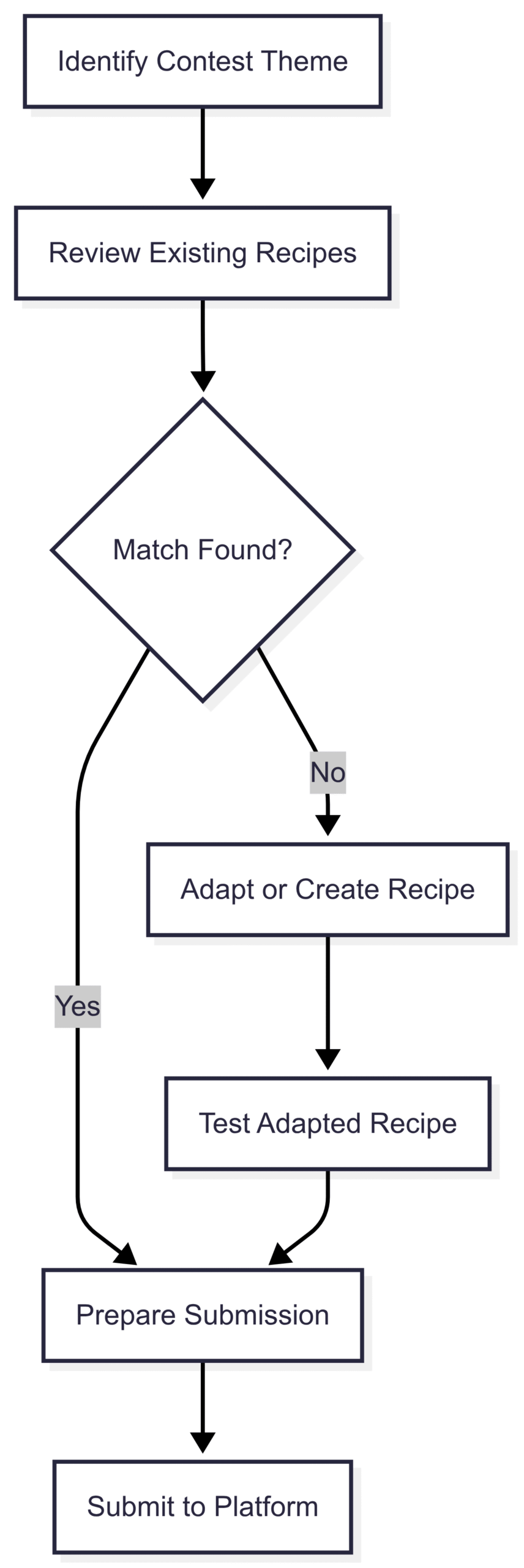
Top Platforms for Recipe Submission
Several platforms are beginner-friendly and offer clear submission processes. Below are four popular options, along with their key features and guidelines.
1. Tasty
- Overview: Part of the Buzzfeed family, Tasty is known for vibrant, video-driven recipes.
- Submission Process: Use their online form to submit your recipe title, ingredients, method, and photo. Agree to the Buzzfeed Materials Release, which grants Tasty rights to use your content.
- Tips: Follow their photo guidelines closely, as visuals are critical for Tasty’s audience.
2. Yummly
- Overview: Yummly aggregates recipes and prioritizes user engagement.
- Submission Process: Add the “Yum button” to your blog or website, allowing readers to upvote your recipes. High engagement increases your chances of being featured.
- Tips: Review Yummly’s formatting and best practices to optimize your submission.
3. Allrecipes
- Overview: A community-driven platform that accepts recipes from anyone.
- Submission Process: Create an account and use the “Add a Recipe” function. Stick to plain text and follow their formatting guidelines.
- Tips: Use descriptive titles and detailed descriptions, like “This creamy lemon cake is a zesty dessert perfect for summer gatherings.”
4. FoodGawker
- Overview: Part of the Gawkerverse, FoodGawker emphasizes stunning visuals.
- Submission Process: Submit original recipes with high-quality images. Editors select content daily based on quality and appeal.
- Tips: Invest in a standout photo to increase your chances of publication.
| Platform | Submission Method | Key Requirement | Best For |
|---|---|---|---|
| Tasty | Online form | High-quality photo | Visual recipes |
| Yummly | Yum button on blog | Reader engagement | Bloggers |
| Allrecipes | Add a Recipe feature | Plain text format | Community |
| FoodGawker | Submission form | Stunning visuals | Photographers |
Building Your Own Platform with WP Recipe Maker
Having your own food blog enhances your credibility and makes submissions easier. WordPress is an ideal platform for food bloggers due to its user-friendly content management system and powerful plugins like WP Recipe Maker.
Why WP Recipe Maker?
- Streamlined Formatting: Automatically formats recipes with templates, ensuring consistency and professionalism.
- Unit Conversion: Converts measurements (e.g., cups to grams) for international audiences, simplifying submissions to diverse platforms.
- Searchability: Organizes recipes for easy retrieval when submitting to contests or themed calls.
- Community Building: Allows you to create submission forms for your own blog, fostering a community of recipe contributors.
Setting Up Your Blog
- Choose WordPress: Set up a WordPress site using a food-focused theme.
- Install WP Recipe Maker: Use the plugin to create recipe cards with customizable templates.
- Optimize for SEO: Include keywords in your recipe titles and descriptions to improve discoverability.
- Promote on Social Media: Share your recipes on platforms like Instagram to build an audience, which many publications value.
Example: Community Cookbook Submission Form
Inspired by Merritt S.O.U.L.’s community cookbook, here’s how you could structure a submission form using WP Recipe Maker:
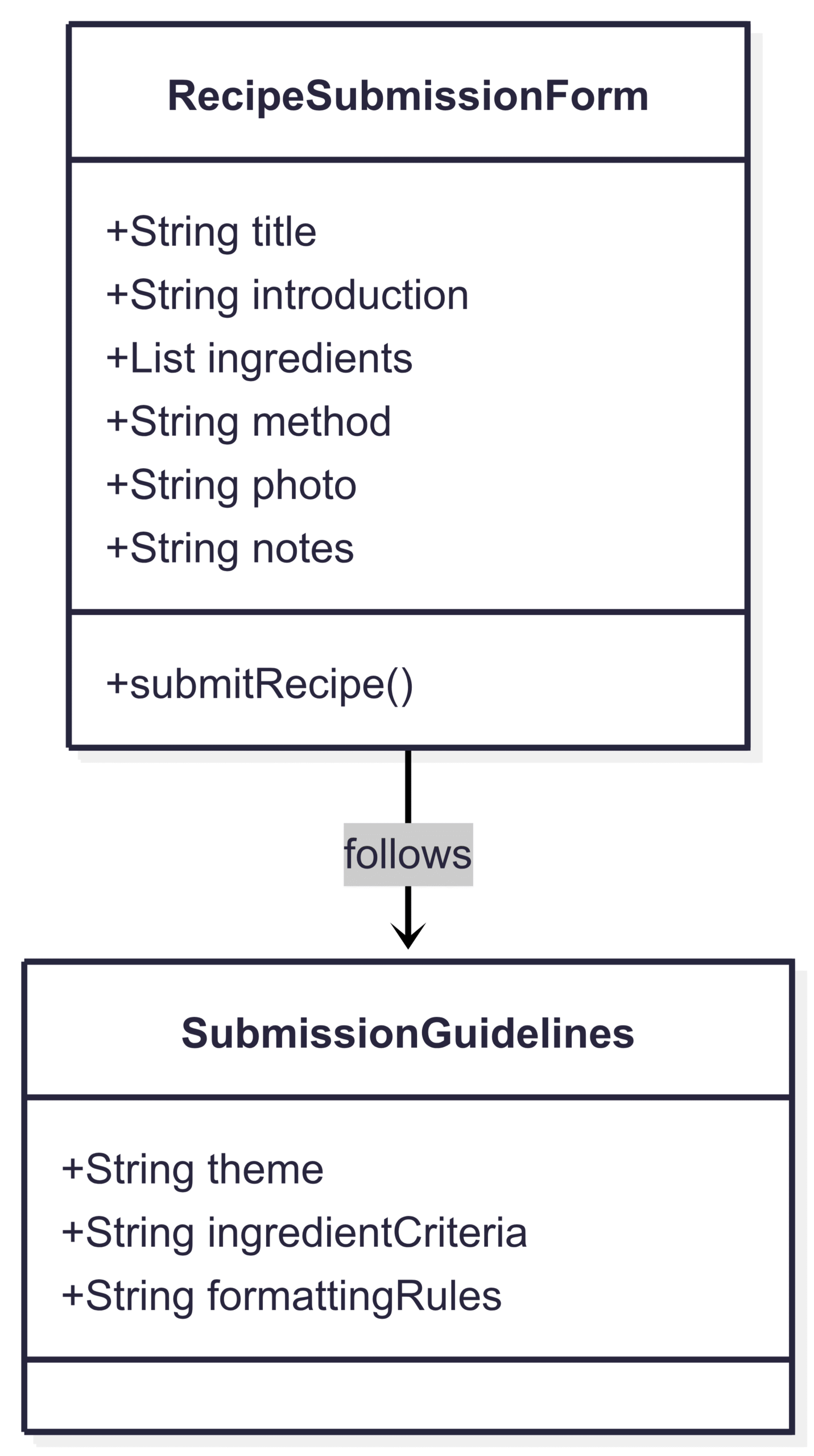
This form ensures contributors provide all necessary details, such as easy, healthy, low-cost recipes using common ingredients, aligning with community-focused initiatives.
Tips for Standing Out on Allrecipes
Allrecipes is a prime platform for aspiring cooks due to its large community and straightforward submission process. Here are advanced tips to make your submission shine:
- Title: Use ingredient-specific titles, e.g., “Garlic Butter Shrimp Scampi” instead of “Seafood Pasta.”
- Description: Write a concise, exciting description, like “This zesty shrimp scampi is a quick weeknight meal bursting with garlic and lemon flavors.”
- Ingredients: List in order of use, with precise measurements and preparations, e.g., “2 tbsp chopped fresh parsley.”
- Method: Be descriptive, include temperatures (e.g., “Sauté on medium heat”), and specify pan sizes (e.g., “10-inch skillet”).
- Doneness Tips: Provide cues, like “Cook until shrimp turn pink, about 3 minutes.”
- Photo: Submit a clear, appetizing image of the final dish.
Maximizing Your Recipe’s Reach
To boost your recipe’s visibility:
- Leverage Social Media: Share your published recipes on Instagram, Pinterest, or X to drive traffic to your blog or the platform.
- Engage with Communities: Participate in forums or comment sections on platforms like Allrecipes to build connections.
- Monitor Trends: Stay updated on culinary trends (e.g., plant-based diets) to create relevant recipes.
- Track Performance: Use analytics tools on your blog to see which recipes resonate, guiding future submissions.
Conclusion
Submitting recipes to platforms like Tasty, Yummly, Allrecipes, and FoodGawker is a powerful way to gain cooking recognition. By crafting compelling titles, detailed ingredients and methods, and stunning visuals, you can create submissions that stand out. Tools like WP Recipe Maker streamline the process, while aligning with themes and contests increases your chances of publication. Start by building your own blog, testing your recipes thoroughly, and following platform guidelines meticulously. With these strategies, your recipes can go from kitchen staples to celebrated dishes shared with food lovers worldwide.
We will meet you on next article.
Please share this Boost Your Cooking Recognition: Recipe Submission Tips with your friends and do a comment below about your feedback.
Until you can read, Tender Slow Cooker Pulled Pork with Homemade Seasoning


